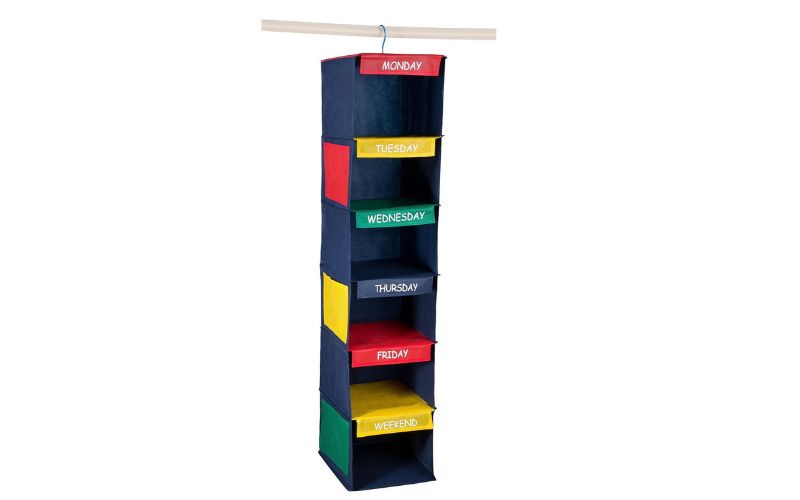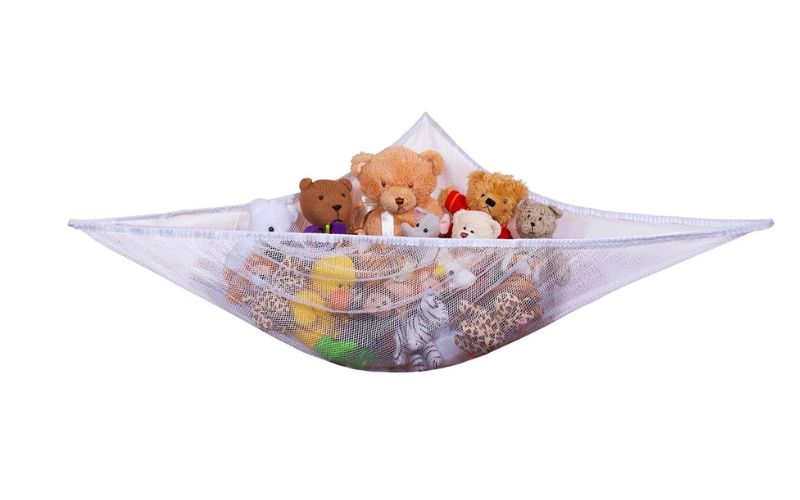Bin Organizer for Toys: Keep Playtime Tidy
Aug 12, 2024

You know the chaos that can dominate a child's play area—scattered toys, lost pieces, and a constant mess. Implementing a bin organizer for toys is a practical solution to reclaim order. By categorizing toys into specific bins, you promote responsibility and simplify cleanup. Imagine a clutter-free space where your children can easily find their toys and where tidying up becomes a routine they enjoy. Ready to explore how to choose the right bin sizes and the benefits of clear labeling to enhance your organization's efforts further?
Maximize playroom space with our Jumbo Toy Hammock – Organize, Store, and Enjoy clutter-free fun today!
Benefits of Toy Bin Organizers
Toy bin organizers help you keep play areas tidy and organized, reducing clutter and promoting a sense of orderliness. Using a toy storage organizer provides a designated space for every toy, making it easier for kids to find and put away their belongings. This keeps the play area clean and teaches children valuable organizational skills.
A toy storage organizer comes in various sizes and configurations, allowing you to accommodate different types of toys and playthings. There's a bin for everything, whether it's action figures, dolls, or building blocks. Children learn to be responsible for their items by categorizing toys into specific bins, promoting a sense of ownership and accountability.
Moreover, utilizing a toy bin organizer can transform a chaotic play area into a visually appealing and inviting space. The neatness and order created by these organizers make the environment more pleasant and playtime more enjoyable. Children are more likely to engage in creative play when their surroundings are organized and free from mess.
Choosing the Right Bin Sizes
The right bin sizes are essential for effectively organizing and storing your child's toys. By choosing the appropriate bin size, you can guarantee that every toy has its place, making playtime tidier and more enjoyable. Here are some tips to help you pick the right bin sizes:
- Assess Toy Types and Quantities: Identify the types and quantities of toys your child has. Smaller bins work great for tiny items like action figures or building blocks, while larger bins are perfect for bulky toys like stuffed animals or trucks.
- Depth Matters: Ensure your bins are deep enough to hold toys securely without spilling over. Deep bins contain toys, making it easier for your child to put them away after playtime.
- Clear vs. Colored Bins: Opt for clear bins so you can see and easily access the toys inside. Alternatively, colored bins can add a fun and organized look to the playroom while keeping things tidy.
- Maximize Vertical Storage Space: Consider stackable bins to maximize vertical storage space in playrooms or bedrooms. Stackable options allow you to use the full height of the room, keeping the floor clear and spacious.
Labeling for Easy Sorting
To make sorting easier, use clear and simple labels on each bin. Labeling bins with 'Cars,' 'Dolls,' or 'Blocks' helps kids quickly understand where each toy belongs. This storage method is not just about keeping things tidy; it also teaches kids responsibility and organizational skills. When you implement a labeling system, children can follow instructions more easily and take ownership of the clean-up process.
Here's a quick table to illustrate some common labels you might use:
| Bin Category | Example Label | Purpose |
| Vehicles | Cars | Organize all toy cars and trucks |
| Dolls | Dolls | Store all doll-related items |
| Building Toys | Blocks | Keep building blocks together |
| Art Supplies | Art Supplies | Gather all crafting materials |
| Games | Board Games | Centralize all board and card games |
Color-Coding for Visual Appeal
Building on the effectiveness of labeling, adding color-coding to your bin organizer creates a more visually appealing and intuitive system for children. Using different colors for each toy category makes it easy for kids to identify and select their playthings, fostering quicker and more enjoyable playtimes.
Color-coding bins or shelves not only enhances organization but also makes clean-up a breeze. Imagine a child knowing exactly where their blocks or action figures go just by the color of the bin. This method can also aid in teaching children about sorting and grouping objects, reinforcing these essential skills in a fun and engaging way.
Here are four key benefits of implementing a color-coded toy bin system:
- Visual Appeal: Bright and diverse colors make the storage area more attractive and stimulating for children.
- Efficiency: Kids can quickly recognize where each toy type belongs, simplifying playtime and clean-up.
- Educational Value: Sorting toys by color helps children learn about categorization and organization.
- Responsibility: A color-coded system fosters a sense of order and responsibility, encouraging kids to keep their play area tidy.
Incorporating these colorful methods will transform your toy storage into a visually delightful and efficient space.
Transform your child's closet into a fun and organized space with our Daily Activity Kids Closet Organizer—Shop now for a tidier tomorrow!

Organizing Art Supplies
When organizing art supplies, start sorting them into categories like markers, colored pencils, and paint. Use clear bins and label them for easy access, keeping everything within reach to encourage creativity. For added convenience, consider a tiered storage cart or drawer organizers to keep smaller items like beads and glue neatly separated.
Sorting by Type
Organizing your art supplies by typing in a bin organizer makes it easy for kids to find what they need and put items away. Sorting items like markers, crayons, and paintbrushes not only streamlines cleanup but also promotes creativity. Kids' furniture equipped with built-in organizers can be a great addition to your child's play area, creating a dedicated and tidy space for their artistic endeavors.
To keep things simple and efficient, consider the following steps:
- Use clear bins or label compartments: This helps children quickly identify where each supply type goes.
- Designate sections for specific supplies: Have separate spaces for markers, crayons, paintbrushes, and paper.
- Encourage responsibility: An organized system makes kids more likely to take care of their materials and avoid losing items.
- Teach organizational skills: Sorting by type can instill valuable habits that your child will carry into other areas of life.
Storage Solutions
By opting for a versatile bin organizer to store your art supplies, you can maximize both space and efficiency. This approach guarantees that everything from markers to paints is easily accessible and neatly stored, making creative sessions with your kids more enjoyable and less chaotic.
- Start by utilizing different bins or compartments to separate items. Place markers in one bin, paints and brushes in another, and paper in its designated spot. This separation makes it easier for kids to find what they need and promotes a sense of organization.
- Labeling bins with specific categories, such as 'Markers,' 'Paints,' and 'Brushes,' can streamline cleanup. When each item has its place, kids know exactly where to return their supplies, which fosters responsibility and tidiness.
- A bin organizer is practical and compact for storing various art materials. Its versatility allows you to adapt the storage space to your needs, whether dealing with a small room or a larger play area.
- When selecting a bin organizer, prioritize functionality and accessibility. This will enhance creativity and workflow, ensuring that art time remains a fun and productive activity for your kids.
Decluttering Tips for Parents
A regular decluttering schedule can guarantee your child's toys are organized and manageable. For instance, if your daughter's room looks like a toy explosion, it's time to take action. Setting aside a specific day each month to tackle toy clutter allows you to keep playtime tidy and stress-free. Here are four decluttering tips to help you get started:
- Sort and Categorize: Begin by sorting toys into categories like dolls, building blocks, and stuffed animals. This will help you see what you have and decide what to keep.
- Donate or Recycle: Encourage your child to choose toys they no longer play with to donate or recycle. This reduces clutter and teaches valuable lessons about giving and sustainability.
- Broken Toys: Look for broken toys. If they're beyond repair, it's best to part with them. This helps ensure the remaining toys are safe and functional.
- Storage Solutions: Utilize storage bins or organizers to keep toys neatly categorized and easily accessible. Labeling the bins can make clean-up time a breeze for you and your child.
Involving Kids in Organization
Involving your kids in organizing their toys teaches them responsibility and keeps things tidy. Assign simple sorting tasks like color coding and labeling bins to make cleanup fun and engaging.
When kids know where everything belongs, they're likelier to put things away.
Assign Simple Sorting Tasks
Getting your kids involved in organizing their toys can be as simple as assigning them sorting tasks like grouping items by type or color. Imagine walking into your daughter's room and seeing everything neatly arranged. You can achieve this by engaging her in simple sorting activities. Not only does this make cleanup easier, but it also teaches her valuable organizational skills.
Here's how you can get started:
- Group by Type: Ask your child to sort toys into categories such as dolls, cars, and building blocks. This helps them understand the importance of categorization.
- Color Coding: Encourage your child to sort items by color. This can be especially fun with art supplies or building blocks, making the task feel like a game.
- Labeling Bins: Let your kids label the bins with pictures or words they can understand. This way, they know exactly where each item belongs, fostering a sense of responsibility.
- Book Sorting: Have your kids color code their books or sort them by size. This keeps their space tidy and makes it easier for them to find their favorite stories.
Make Cleanup Fun
Transform cleanup time into an enjoyable activity by turning it into a game for your kids. Involve your children in organizing tasks to teach responsibility and organizational skills. For instance, in your daughter's room, let her label bins, color code books, and sort art supplies. This interactive approach makes tidying up more engaging and helps her learn organization.
Kids feel motivated to maintain order when they actively participate in the process. Encourage them to take ownership by teaching them where items belong. Generic labels for toy categories simplify cleanup for younger children, making organization more efficient.
Here's a simple way to incorporate fun into clean-up time:
| Activity | Description |
| Labeling Bins | Let your child create labels for each bin. |
| Color Coding | Use colored stickers to sort books or toys. |
| Sorting Art Supplies | Teach them to group markers, crayons, etc. |
| Matching Games | Turn sorting into a game of matching items. |
Maximizing Small Spaces
Maximize small spaces using a bin organizer to keep toys neatly stored and accessible. A compact design with multiple bins can make a difference in your daughter's room. You'll transform cluttered corners into organized havens where every toy has its place and is easy to find.
To get the most out of your bin organizer, consider these tips:
- Opt for a Compact Design: Choose an organizer that fits snugly into your daughter's room but still offers plenty of storage. This way, you're not sacrificing valuable floor space.
- Label Each Bin: Clearly label each bin with the type of toy it contains. This will help your child know where everything goes and promote quick cleanup.
- Stackable or Collapsible Bins: Invest in organizers with stackable or collapsible bins. These flexible storage solutions allow you to expand or reduce your storage as needed without taking up extra space.
- Sturdy and Durable: Pick a bin organizer that can withstand playtime's daily wear and tear. Durability is key in small spaces where items are frequently moved around.
Conclusion
Using a bin organizer for toys, you're not just tidying up but teaching valuable skills. With the right bin sizes, clear labels, and color coding, your kids will find cleanup fun and easy. Organize art supplies, involve the kids, and maximize small spaces for an efficient play area. If you ever feel overwhelmed, don't hesitate to seek professional help. Keep playtime enjoyable and mess-free, and watch your children thrive in a tidy environment.


